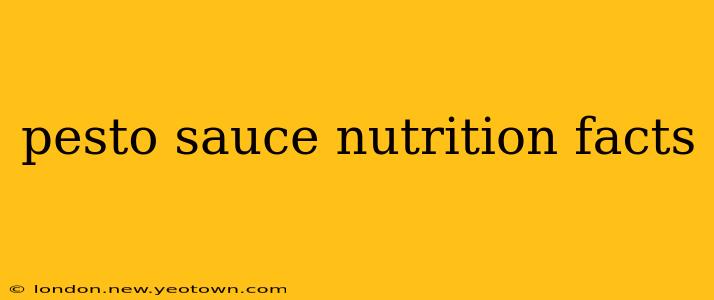Pesto. The very word conjures images of sun-drenched Italian hillsides, fragrant basil, and vibrant green sauce clinging lovingly to pasta. But beyond its deliciousness, what are the nutritional facts behind this culinary star? Let's delve into the details, exploring the nutritional benefits and potential drawbacks of this popular condiment.
Our journey begins with a classic basil pesto, understanding that variations exist depending on the specific recipe and ingredients used. This analysis will focus on a typical homemade version, offering a general understanding of its nutritional profile.
What are the macronutrients in pesto?
A typical serving (about 2 tablespoons) of homemade basil pesto contains a surprisingly balanced mix of macronutrients. We’re primarily talking about healthy fats, carbohydrates, and a moderate amount of protein. The exact amounts will fluctuate based on ingredients, but expect a rough breakdown like this:
- Fat: A significant portion of pesto's calories comes from healthy fats, primarily from the olive oil which forms its base. Olive oil is rich in monounsaturated fats, known for their heart-healthy benefits.
- Carbohydrates: The carbohydrates in pesto mainly originate from the basil leaves and, depending on the recipe, pine nuts or other nuts. These carbs provide energy, but the quantities are generally moderate.
- Protein: While not a primary source of protein, pesto does contribute a small amount, mostly from the nuts and cheese (if included).
How many calories are in pesto?
The calorie count in pesto can vary substantially. A 2-tablespoon serving might range from 100 to 150 calories, depending on the type and amount of olive oil, nuts, and cheese incorporated. Using less olive oil will significantly decrease the calorie count. Opting for lower-fat cheese also makes a difference.
What are the vitamins and minerals in pesto?
Beyond macronutrients, pesto boasts an impressive array of vitamins and minerals. Here are some key highlights:
- Vitamin K: Basil is a good source of vitamin K, crucial for blood clotting and bone health.
- Vitamin A: Both basil and olive oil contain antioxidants like beta-carotene, a precursor to vitamin A, essential for vision and immune function.
- Iron: While the amount isn't massive, pesto contributes a small amount of iron, vital for red blood cell production and oxygen transport.
- Magnesium: Pine nuts, a common ingredient, are a good source of magnesium, essential for muscle function and nerve transmission.
Is pesto healthy?
The healthiness of pesto largely hinges on the ingredients and portion size. A homemade pesto made with fresh basil, high-quality olive oil, and moderate amounts of nuts and cheese can offer several health benefits, including:
- Antioxidant properties: The abundance of antioxidants in basil and olive oil helps protect cells from damage caused by free radicals.
- Heart-healthy fats: The monounsaturated fats in olive oil contribute to heart health.
- Nutrient richness: Pesto provides a variety of vitamins and minerals, adding nutritional value to meals.
However, overconsumption can lead to increased calorie and fat intake. Using excessive amounts of cheese or nuts can significantly boost the calorie and fat content. It's always best to enjoy pesto in moderation.
What are the potential downsides of eating pesto?
While generally healthy, there are some potential downsides to consider:
- High fat content: Pesto's high fat content can be a concern for individuals watching their fat intake.
- Allergic reactions: Some individuals might be allergic to nuts (especially pine nuts) or basil.
- Sodium content: Depending on the recipe, added salt can increase sodium intake.
Can you list some healthy variations of pesto?
Absolutely! Experimenting with different ingredients can create healthier and equally delicious pesto versions:
- Sunflower seed pesto: Substitute sunflower seeds for pine nuts for a lower-fat, allergy-friendly option.
- Walnut pesto: Walnuts offer a slightly different flavor profile and a good source of omega-3 fatty acids.
- Reduced-fat pesto: Use less olive oil or a blend of olive oil and water.
Enjoy pesto responsibly, appreciating its flavor and nutritional benefits while maintaining mindful portion control. Its vibrant green color and fresh taste are a testament to the power of simple, wholesome ingredients.

